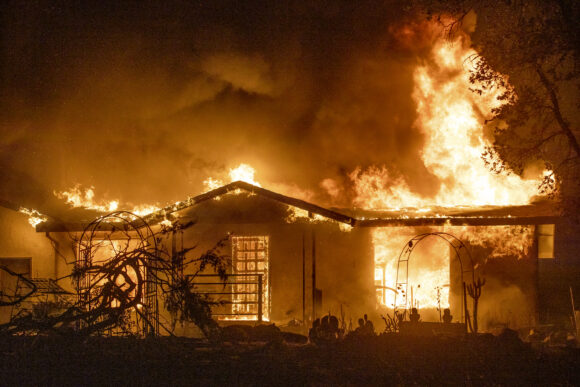A proposal by California’s insurance regulator to require insurers to write more policies in areas at risk of wildfires is more a promise than a plan, but the announcement is giving data analytics vendors a new way to pitch their services to insurers.
Their message: Find the least risky properties now, or scrape through the dregs later through adverse selection.
Insurance Commissioner Ricardo Lara says he has an agreement with insurers to write at least 85% of their statewide market share in areas with high wildfire risk. In other words, an insurer that has 10% of the state’s homeowners market would have to write 8.5% of its business in wildfire zones designated by the Insurance Department.
Lara hasn’t released any more details since announcing the plan in September. For now, the most concrete impact of the proposal appears to be the opportunity it is offering to data vendors that have wide access to high-resolution aerial imagery and detailed data about historic wildfire losses.
One element of Lara’s plan would allow insurers to file rates that use predictive models to estimate risk, a significant change from current rules that allow only historic loss data to be used.
The new rules would also require insurers to file rates that offer discounts to property owners that have taken mitigation measures to reduce wildfire risk, such as clearing vegetation or using fire-resistant materials. Lara approved regulations last year that allowed rate filings with mitigation discounts but they are not yet mandatory.
The discussion about a new way to set rates provides an opening to predictive analytics vendors such as Guidewire Analytics, based in San Mateo, California; and ZestyAI, headquartered in Oakland.
“If you have to go write in high-risk zones, its better for you to have a sniper rifle than a shotgun,” said ZestyAI Chief Executive Officer Atilla Toth.
Going Granular
The California Insurance Department last month approved a rate filing by the California Fair Access to Insurance Requirements plan that uses ZestyAI’s Z-Fire product to provide discounts to homeowners who have “hardened” their homes to resist wildfire damage.
The FAIR plan is the state’s last-resort property insurer and has become the only choice for many property owners who live in severe wildfire hazard zones. The number of FAIR plan policies has increased from 126,709 in 2018 to more than 340,000 in October 2023, a spokesman for the insurer said. Total exposure for the plan is now $290 billion.
Seven of the state’s 12 largest property insurers have pulled out of the California market entirely or are no longer taking on more risk, according to the Insurance Department. Rate filings show that carriers who are still in the state are seeking rate increases ranging from 20% to 40%.
California’s Proposition 103, approved in a 1988 ballot measure, requires insurers to receive prior approval by the state Insurance Department to raise rates. Insurers say rates based on historical data aren’t keeping up with rapid increases in wildfire frequency.

“We’ve seen carriers pull out of writing new business in California because they have been unable to achieve the premiums they believe are necessary to cover the rising climate risk,” Toth said. “The whole insurance business model fails if insurance carriers cannot collect enough premiums to cover claims and expenses.”
Toth said research by his company found that mitigation efforts such as vegetation management and using fire-resistant materials can reduce a property’s wildfire risk by 50%. Topography and climate also play a role in an individual property’s risk: Buildings on sloping properties, for example, are more likely to burn.
ZestyAI determined that California could avoid up to 26% of the economic losses from wildfire if all homeowners in wildfire-prone areas were to clear the vegetation within 30 feet of their homes, and 45% of economic losses if homeowners cleared the vegetation up to 100 feet.
The report says 62% of homes with heavy vegetation five to 30 feet from the structure were destroyed in wildfires, compared to 35.1% of homes with only light or medium vegetation within the same zone.
Toth said the conventional models used by insurers to access risk use basic data, such as the distance to a fire station or fuel source, to assign the risk of wildfire damage. ZestyAI uses aerial imagery and other sources and applies machine learning to understand key risk factors. Z-Fire produces two scores for each property. One predicts the likelihood of a wildfire and the second predicts the probability the property will be damaged in wildfire.
Using ZestyAI
Toth said said insurers that hold a 40% share of the homeowners insurance market in California are using ZestyAI, most of them for risk selection. He said in addition to FAIR plan, Amica MetLife and Farmers have approved rate filings that use ZestyAI. He said the fact that Z-Fire was developed using historical data and not simulations was one of several factors that led to Insurance Department approval of those filed rates.
So far, ZestyAI’s product has been used for risk assessment and to set the level of discounts offered for various mitigation factors. Lara says he also intends to adopt regulations before the end of the year that will allow insurers to use predictive models to establish average rates.

Roger Arnemann, senior vice president and general manager for Guidewire, said that change will mark a “watershed moment.” He said that insurers that use products such as Guidewire’s HazardHub to identify the lowest risk properties within high-hazard areas will have a competitive edge.
In California, 90% of the property damage caused by wildfire is concentrated in the 10% of the state with the highest wildfire risk, Arnemann said. But within those wildfire zones, some properties are much less likely to burn than others.
Guidewire assigns wildfire risk scores to geographical areas on a scale that ranges from A to F. Arnemann said there is a wide variation of exposure among properties in the risky D and F zones. Through a partnership with Betterview and Cape Analytics, Guidewire can offer data specific to individual properties, allowing insurers to choose properties that are less risky than their neighbors.
Arnemann said property and casualty insurers need to adjust their approach to the market if they want to maximize their advantage. Those that use forward-looking insights will stay ahead of the competition, he said.
“We think you can profitably write hazards in the F zones if you are smart about it,” he said.
Real Problems
According to Lara, the absence of profits for insurers is part of California’s wildfire problem. The commissioner said California homeowners insurers suffered a 13% loss in 2022, while nationwide the homeowners line produced a 3.6% profit.
Lara said his “sustainable insurance strategy” will allow insurers to raise rates high enough to give insurers a fair return along with their commitment to expand coverage into risky areas. Lara said his plan would mark the most substantial change to California’s insurance industry since passage of Proposition 103.
But the commissioner faces pushback from the nonprofit organization that championed Proposition 103, Consumer Watchdog. The organization says documents it obtained through a public records request reveal that Lara’s plan would allow insurers to offer “bare-bones” policies with thin coverage to meet their obligation to write more business in wildfire hazard zones. The commissioner would also be allowed to waive the requirement for insurers that say they can’t expand coverage, the group says.
Carmen Balber, executive director of Consumer Watchdog, said Lara’s wildfire plan is nothing more than a press release and bulletpoints. She said the documents obtained through the organization’s public records request show that Deputy Insurance Commissioner Michael Martinez was shopping around proposed legislation that state lawmakers refused to introduce. Consumer Watchdog posted the language of the proposed bills and emails discussing it on its website.
Balber said Lara announced his plan to adopt regulations to accomplish his “sustainability plan” only after state lawmakers showed him the door. The Insurance Department had not proposed any new regulation as of Friday.
“We’ve seen language on none of it,” Balber said.
When asked for a copy of any documents that lay out the terms of Lara’s plan, Press Secretary Gabriel Sanchez provided a link to the webpage that offered a broad description of the strategy.
“The timeline for the implementation of these measures is immediate and urgent, with a goal to complete necessary changes by December 2024,” Sanchez said in an email.
Claims Journal asked for any documents that show the wording of the proposed rules, but Sanchez did not provide any with his reply.
“Insurance companies will have to give us the details where they are writing new policies,” he said. “And the department will enforce this through our rigorous review of insurance companies’ rate filings.”
Sanchez said Consumer Watchdog is “flat out wrong” about the plan allowing insurers to offer bare bones policies. He said the department has had conversations with the legislature about the wildfire plan, but no bill was introduced. He said the discussion alone was a win.
“These discussions were in response to real problems that Consumer Watchdog denies,” Sanchez said. “They are not helping anyone get insurance. We are.”
Raising Rates
Rules filed with the Insurance Department show that a few insurers are offering new discounts for homeowners who have taken steps to protect their properties from wildfires. Pacific Specialty, for example, proposes to use Verisk’s FireLine Wildfire Hazard and Mitigation Score to offer discounts of up to 12%. Clearing vegetation within 30 feet of the home is good for a 2% discount. Participation in a community wide fire-prevention plan can earn a discount of up to 3%.
Nationwide is proposing to offer discounts to homeowners located within communities that participate in the Firewise USA Recognition Program and the Board of Forestry and Fire Protection’s Fire Risk Reduction program. The insurer is also offering discounts for properties that have made improvements that comply with the Insurance Institute for Business & Home Safety designation.
ASI Select Insurance Corp. is proposing to offer discounts using the Willis Re wildfire hazard score, which draws from historic wildfire losses, the US Forestry Service’s stochastic wildfire model and research published by the Fire Protection Association and US Department of Agriculture.
Mostly, though, the rates filed since Lara announced his plan show that insurers want to charge much higher premiums.
On Sept. 21, the same day that Lara announced his wildfire plan, Amica filed a proposal to increase rates by 40.1% on Dec. 1. USAA requested a 20.1% increase, to take effect Aug. 1. Western Mutual and Residence Mutual are proposing 28.7% increases effective May 1.
None of those rate filings have been approved yet. Insurance Department records, however, show that regulators have approved 29 rate hikes proposed by insurers this year. Zurich American Insurance Co. received permission to hike rates by 29.8% after asking for a 37.1% increase. California Automobile Insurance Co.was approved for a 12.6% increase, State Farm General 6.9%, and Farmers Insurance Exchange 17.7%.
In the past three years, the average approved rate filing averaged 12.39%, Insurance Department records show. That is only slightly less than the average 13.05% hike that was requested.
“Unfortunately, climate change — climate risk — is not free,” Toth said.
Top photo: In this Sept. 27, 2020, file photo, a house burns on Platina Road at the Zogg Fire near Ono, Calif. (AP Photo/Ethan Swope, File)
Was this article valuable?
Here are more articles you may enjoy.


 Singer’s Elliott Sued by PE Firm in Escalating Fight Over Money
Singer’s Elliott Sued by PE Firm in Escalating Fight Over Money  California Governor Seeks $200M to Replace EV Tax Credits Cut by Trump
California Governor Seeks $200M to Replace EV Tax Credits Cut by Trump  JPMorgan Wins Gender Pay Gap Dispute Against London Analyst
JPMorgan Wins Gender Pay Gap Dispute Against London Analyst  Munich Re: Insured Losses From Wildfires, Storms and Floods Hit Record High
Munich Re: Insured Losses From Wildfires, Storms and Floods Hit Record High 